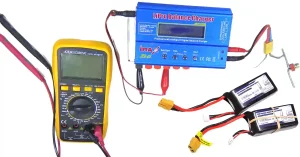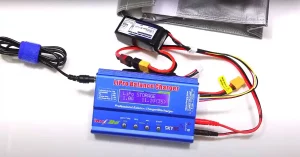Having fun with your RC car or train or any drones? But then it stops working because the charge is all drained.
Then you suddenly realize your LiPo battery won’t charge?
There can be many reasons why the LiPo battery won’t charge. The key reason is when the LiPo battery is overcharged. When the LiPo battery is discharged, the charger does not connect with it. Other reasons include swelling up of batteries, a faulty charger, or a drop in the voltage level.
If you have got a minute then read away and find out the wonders as well as unanswered questions inside your head.
Reasons Why LiPo Battery Won’t Charge
Many issues may arise with the charging of LiPo batteries. Such as swelling as a result of overcharging is a regular problem. You can apply various methods for depuffing a swollen LiPo.
The charging issue with LiPo batteries has a very simple source. Not to mention a simple solution!
When a LiPo battery cannot be charged, the balancing charger is unable to connect to it. Either they cannot be charged, or it is because of a low voltage mistake. That is precisely the issue with the battery.
When the voltage of the LiPo battery falls below a particular level, it becomes flat. So, it will not charge. Charging a low-voltage LiPo battery is hazardous.
So, when we charge it with a balance charger, it will not charge due to the danger.
To summarize, the LiPo battery also isn’t charging because it has become dangerously overcharged. We can avoid this by keeping an eye on the discharge rate.
Let’s look at the fix now that we’ve determined the cause.
Way To Revive A Dead Cell Of A LiPo Battery
We’ve all tried to fix the LiPo battery with dead cells before. First, we need to connect to the battery tester or goggles. After that, don’t forget to unhook them when we’re through. Otherwise, the battery tester will not even show a voltage.

Maybe we should change the battery because it is no longer functioning correctly, as per several experts.
They might be accurate. However, we might be able to retain the battery. After reviving it, we can use it for a little longer.
Things We Will Need
When a LiPo battery is entirely discharged, the cells also oxidize, which contributes to its poor performance.
However, if you notice it quickly enough, you can generally conserve the battery. By also sacrificing not too much functionality.
So, for rescuing your batteries we need:
- A drained LiPo battery.
- A balancing charger for LiPo batteries.
- A charger for NiMH batteries.
It’s rather simple to recover such batteries using this equipment. However, if you are looking for a balancing charger I have some suggestions for you.
| Product 1 | |
| Product 2 |
4 Simple Steps For Reviving:
- Connect your LiPo battery’s main connector to your NiMH adapter. After that, simply charge at the lowest feasible current.
This is usually 0.1A. If your charger enables you to choose the voltage, then choose one that matches the nominal voltage of your LiPo battery.
- After a minute or 2 the batteries should have returned to 3.3 volts for each cell. Simply take a look at your battery’s total voltage. Divide the total voltage by the total number of cells.
- When the total voltage reaches roughly 3.3 volts per cell. Transfer the battery to the LiPo balancing charger and balance the charge at 0.5C. This will take longer than charging at 1C, however, it is safer.
- When the balance charge is finished, you should have a completely restored LiPo battery.
However, following the instructions given here. It can be very dangerous. You should follow these at your own risk.
Proper Care For The Battery/Tips And Tricks For Safe Battery Use
There are some proper tips to take care of a LiPo battery. Those are given below
- Sharp edges should never be used to strike a battery.
- A cell’s folding edge should never be opened or deformed.
- Batteries should never be dropped, hit, or bent.
- The cells should never be disassembled. Disassembly may produce a short circuit inside the cell, resulting in gassing, fire, or other issues.
- Never burn batteries or dispose of them in a fire. These could trigger the cells to fire, which is quite harmful.

Other than these precautions, we should use LiPo batteries with care after and before charging. For example,
- Never overcharge a LiPo battery. Every cell should not fall below 3.2-3.3V.
- Put away any combustible products when recharging a LiPo battery
- When charging a LiPo battery, do not leave it unattended.
- LiPo batteries should not be stored in hot environments. Also, avoid charging in direct sunlight.
- Recharge the LiPo battery while it is enclosed inside an anti-flame container.
This technique more or less works in all rechargeable batteries. If you are also having problems with your DGi battery charging this might help you.
LiPo Battery Disposal
Well, let’s say the battery is completely lost. Then there is the proper way to dispose of a battery.
Discharge The LiPo Battery As Far As You Can Safely
You can discharge the LiPo batteries in various methods. The LiPo chargers often comes with automated discharge capabilities. If there was no charger with such a discharge option, anyone can discharge it in the vehicle.
However, you risk starting a fire and perhaps damaging your vehicle if you do so. That is why, you need to make sure there are safety equipment around you.
We may also make your discharge rig out of a rear bulb and some wire. Merely solder a male connection to the tabs of a taillight bulb and plug in the battery. While doing this, keep the battery in a protective container. This container must be fireproof.
Immerse The LiPo In A Bath Of Salt Water
Combine table salt and lukewarm (not hot) water. Continue to add salt until it no longer dissolves in the water. Ensure that all of the cables are completely immersed.
The saltwater is very conductive and it will effectively burn out the battery, further depleting it. Allow at least 24 hours for the battery to soak in the saltwater bath.
Check The LiPo’s Voltage
If the battery voltage is 0.0V, you can prepare to remove it. Use salt water to soak the batteries in case the voltage are not 0.0V. Usually soaking them for 24 hours can discharge them easily. If it does not work, repeat this process until the battery hits 0.0V.
Throw The Battery Inside The Garbage
LiPo batteries usually don’t harm the environment. However, the NiMH and NiCd batteries can be harmful. We can throw them in the garbage anytime without a worry.
FAQs
How long does it take to charge a flat LiPo battery?
If you have a 3S battery, LiPCo charging should take about 10-15 minutes. However, it varies based on how charged it was. It takes from 70 minutes to 80 minutes for the batteries tobalance charge.
What is the lifespan of a LiPo battery?
They estimate that LiPos have a normal life span of 150 to 250 cycles. The LiPo batteries are usually drained when they reach 3.0V or lesser. They also heat up for using a long time. Physical harm and water also may shorten their lives.
How can I tell if my LiPo battery is completely charged?
When the cells reach 4.2 volts, a smart charge begins reducing the amps. At the same time, the cells preserve the voltages to top off the batteries. Simply leave them there till they are finished. When a LiPo cell has a no-load voltage of 4.2 volts, it is considered completely charged.
Conclusion
We hope this clears your confusion about why a LiPo battery won’t charge.
Simply try to recover it. However, if that’s a fail, follow the procedures to throw it away
Thank you for reading.
Till next time!


